News
July
seminars
There are no seminars scheduled for July.
Updated
web pages @ www.jaunay.com
The web page, What
you can expect to see on an historical* AUS BDM certificate has been
updated. WA online indexes have been extended: Births
to 1931, and deaths to 1931. DPS Perth has marriages online for 1906–1942.
Qld indexes are now online to 1914 for free.
The NSW website has changed the embargo notices from a designated year
to a period of time—births restriction is now 100 years, not 1905.
Deaths 30yrs, and marriages
50 years.
SA BDM Transcription
Agents
Following a question posed at the May FPFHG Seminar day regarding
the so called SAGHS transcription service mentioned on the SA-GEN
mail list on 20 May 2007. I advise that SAGHS is not the only
group given permission to transcribe certificates. Anyone who can
access
District Registrar filmed certificates
may transcribe them. They may not photocopy them.
As a consequence Adelaide Proformat has been offering such a
service which has been widely used since 1994. The records available
for transcribing
can be viewed at the website.
However, although I spoke to the Registrar about a Transcription Agency
some 5 years ago I need to point out that neither SAGHS nor Adelaide
Proformat can call themselves Transcription Agents as the process
is not using the certificates issued by the BDM Registry but rather
copying
the duplicates issued by the now defunct District Registrars.
Missing death
records
Are
you aware that there are 67 known missing entries from
the SA Deaths 1916-1972 CD. Check the list.
In this issue:
News
• July
seminars
• Updated web pages
• SA BDM Transcription Agents
• Missing death records
Delving
into old family photographs
![]()
Adelaide
Proformat
5 Windana Mews
Glandore SA 5037
Australia
Tel: +61 8 8371 4465
Fax: +61 8 8374 4479
proformat@jaunay.com
Services
• Research
• Drafting charts
• Locating documents
• Seminar presentations
• Writing & publishing
• SA lookup service
• Ship paintings
Delving
into old family photographs
pt 4
To identify a photograph and thus date it requires the researcher to undertake
the following detailed examinations. In past issues we dealt with:
1. Determining the type of photograph.
2. Analyse the mounting board itself.
3. Examine the back of the mount for printed information.
4. Examine the composition of the image—the pose and background.
In this issue we will examine the fifth and least reliable factor in dating
photographs—the clothes worn by the subjects.
What we can be sure of is that our nineteenth century ancestors were usually
dressed in their Sunday best for their photograph! It was an expensive
treat undertaken more often than not to record special occasions. If their Sunday
best was not good enough for the studio, then they may be dressed
in borrowed clothes—some studios maintain wardrobes for this purpose!
While the way people dress is also determined by fashion, unfortunately
we can never be sure that our subjects were wealthy enough or even motivated
sufficiently to keep up with the latest fashion. Many older people settled
for a particular type of clothing and hairstyle and ignored the changing
fashions.
The best
we can say when looking at the way our ancestors were dressed is that a
particular style of suit or dress was not available until a certain date
and therefore the photograph cannot be earlier than that date! The most
obvious example of this has to be the men’s three-piece suit that
was unheard of before the 1870s. Some fashions such as mens' ties and the
leg of mutton sleeve of the 1890s can be dated very precisely by their
form:



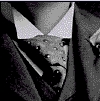
L–R: Mens' ties 1870, 1875, 1890, 1893.

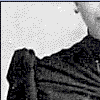

L–R: Leg of mutton sleeves to bodice 1892, 1893, 1894.
Decade |
Women |
Men |
Children |
| 1860s | High necklines with small collars & brooches; full sleeves; single coloured crinoline dresses; hair parted in centre; ears exposed by the end of the decade. | Either a full beard or large moustache but not both; contrasting often patterned waistcoat; darker jacket than trousers; curved brim in top hats; wide sleeves and trouser legs; raised seams in trousers. | Tartan popular for young children; short crinolines for girls showing pantaloons. |
| 1870s | Cluttered necklines; bustles; coloured heavily trimmed complicated dresses; hats tilted forward to accommodate high built up hair styles. | Tight fitting jackets; all pieces of the suit match; broad lapels; top hat brims narrow; homburg hats; spats; pointed toes on shoes. | Sailor suits for boys; elaborate dresses for girls; sisters dress alike. |
| 1880s | High collars with piecrust frills; hair styled but plain; small bustles; dresses with fitted tailored plainer tops; small hats with items from nature. | Full beards and moustaches; bowler hat; boaters make an appearance; pointed toes on shoes. | Sailor clothes for boys and girls; very elaborate costumes for young children. |
| 1890s | Elaborate tops and blouses; plainer dresses; small hats and boaters; leg of mutton sleeves. | Lounge suits; high shirt collars; straw boaters common. | Adult-like clothes; smocking common in young children; sailor themes. |
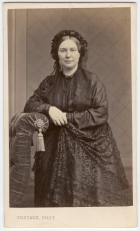 |
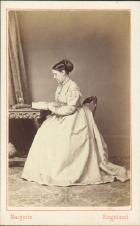 |
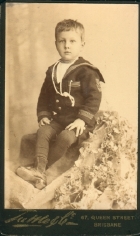 |
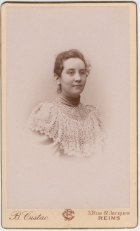 |
| Ann Jaunay nee Gilmour b. 1823 shows off the high necklines with small collar &; full sleeves; single coloured crinoline dresses of the 1860s. | Mary Jane Cawley nee Puttick b. 1883 illustrates the distinctive hair styles of the 1870s. Note the bustle. | Sailor-suited Louis Frank L Jaunay b. 1884 Melbourne in Brisbane QLD. Such suits were popular for girls too by the 1890s. | Louisa Krug b. 1874 Reims demonstrates the popular elaborate lace blouses of the 1890s. |
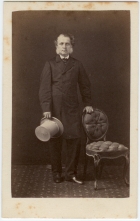 |
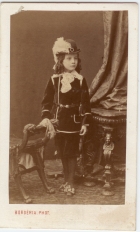 |
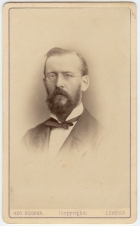 |
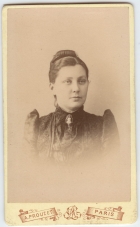 |
| Joseph Cawley b. 1817 holding his 1860s curved brim top hat wearing his coat with wide sleeves. | Joseph Krug b. 1869 Reims at his overdressed best the fate of many young boys of the 1870s! | August Feige's full beard and moustache reflects the fashion of the period led by the Prince of Wales in the 1880s | Mary Jaunay nee Cawley b. 1860 showing the popular leg of mutton sleeves of the 1890s. |
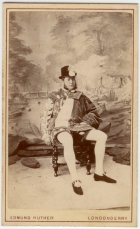 |
Justice Gilmour McCorkell of the Bombay Presidency India b. 1849 London in his official robes of office. | 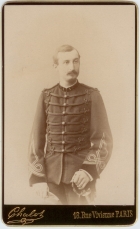 |
Cpt Robert Schlumberger later a Brigadier-General in the French army in WW1 b. 1859 Nancy in his military uniform. Officers' tunics had 7 buttons before 1910 and then 9. |
When we couple the data gleaned from a close examination of all aspects
of a photograph and our family knowledge we can often pin down the date
of a photograph very precisely.
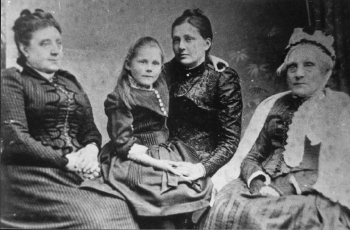
The woman nursing the child (Mary Jaunay nee Cawley) is wearing a dress with leg of mutton sleeves that date 1892. Although not clear here the same dress is depicted in another photograph above. Her mother to the left (Mary Jane Feige fmrly Cawley nee Puttick) has sleeves of the same style. While her mother on the right (Mary Puttick nee Cox) is not so concerned with fashion in keeping with an 83 year old woman. Since old Mary died in Jan 1893. We know this photograph must have been taken in 1892.
This series of articles has been adapted from Graham Jaunay's booklet: Identifying and dating 19th century family photographs.
Note: All photographs displayed are
from the family albums of Graham Jaunay.
They are currently subject to
copyright as they appear in publications by Graham Jaunay.